Battle and war played a key role in the life of the Celtic tribes in Gaul. Especially for the nobility, but also for common people, war was an important part of their lives. Often this occurred in the form of skirmishes between smaller groups, but there have also been battles with tens of thousands of combatants. Referring to the Helvetii tribe around 50 BC, Caesar says that 92,000 of a total of 350,000 Helvetii were fit to bear arms. This would make roughly a quarter of the population warriors.
The Celtic warrior
Most wars between the different Celtic tribes would likely have been minor conflicts. They usually occurred as a consequence of armed attacks on neighboring tribes, since this kind of robbery was common practice and rewarded the respective leader with honor and glory. Caesar’s reports and also Gaelic legends concerning Finn McCool and Cu Cullain from Ireland verify this. There was, however, the possibility of acts of revenge and counterattacks escalating in certain circumstances. Battle season was normally in late spring and summer, weather permitting, once the fields were tilled and the harvest not yet on the cards.
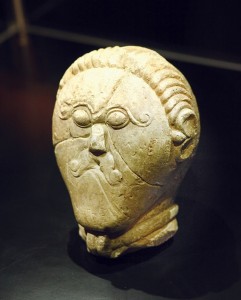
Image: “Stone sculpture of a Celtic hero”
The nobility saw itself as the elite warrior caste and spent a lot of time training with weapons. Even the free men, who owned land themselves, had to be able to defend their estates against raids – or attack the enemy themselves. However, due to their preoccupation with agriculture, they would only have had limited time to train with weapons.
Women also played a role in the Celtic warrior cult: According to historical sources, they encouraged the warriors and punished cowards, who fled the battlefield, with sometimes physical disdain. There are only very few reports and no actual material findings of female warriors, for example swords and armor have not been found in female grave sites. In contrast, weaponry can be found in almost half of all male graves.
Equipment
The main weaponry of a Celtic warrior were the spear and sword, even though weapons like hammers, axes and slingshots have also been recorded. Usually he carried a long battle spear measuring around 1.8m, the “Lancea”. It had a broad metal tip up to 50cm in length. In addition, he carried short throwing spears called “Gaesum”.
Image: Celtic sword and scabbard circa 60 BCE
Image: “Scuto Battersea BritMu252a”
A large wooden shield measuring up to 1.2m in length and half a meter in width served as protection. It was usually covered in leather, painted in all sorts of colors and with a metal shield boss in the middle. The common warrior wore his normal civilian clothing to battle: A pair of Bracae (pants), a shirt similar to a tunic and a gown or overcoat.
The typical weapon was the longsword with a blade length between 80 and 100cm. The early variants of these swords were shorter and had a hammered-out point, which meant the sword could be used both to serve blows and for stabbing. The later swords tended to have blunt points and could only be used to serve blows.
Image: British-Museum: “Waterloohelmet”
Celtic aristocrats may have also worn jewelry like the typical Celtic necklace. It is likely they wore armor and helmets mostly made from leather. Occasionally, armor made from bronze and iron were also used; there are records of chainmail and bronze breast plates. Particularly luxuriant armor was also adorned with golden ornaments and semi-precious stones. An especially beautiful helmet was found in Ciumesti in Romania. It was decorated with a replica of a raven with flexible wings. Such a helmet must have been striking on the battlefield.
Image: “Celtic Helmet from Satu Mare, Romania”
Celtic warfare
Compared to the strict military organization of Rome’s legions, the Celts were much less disciplined. Ancient reports often speak of unorganized detachments; in open-field battles, the Celtic warriors’ strategy seems to have been mainly to charge towards the enemy and to overpower them by sheer force.
Elaborate strategies and clever tactics were apparently not for the Celts. This may be due to a peculiarity in the Celtic mentality, which honored individual skill in battle more than the disciplined and concerted actions of many warriors of a combat team. Military infantry units were instead set up according to the warriors’ origins rather than the type of weapon they used. Cavalry and chariots, however, were sorted by category.
The Celtic chariot
The Celtic chariot was a typical element of Celtic warfare, even though it was not used in every corner of the Celts’ sphere of influence and at all times. The chariot was a light vehicle with two wheels, horse-drawn via a yoke. The vehicle normally didn’t exceed a length of 4 meters and a width of 2 meters.
The chariots were made almost exclusively from natural materials; only the wheel hubs’ casing and the outer sides of the wheels were made from metal. Some pull rings and pegs were also occasionally made from metal to improve stability. However, the real highlight of the chariot was the suspension: The platform was not rigidly attached to the axle, but left hanging freely in a guying. This made the chariot easier to maneuver and gave the warriors a more stable footing.
The chariot was manned by two warriors. The charioteer sat in the open front part of the vehicle and steered it. The other warrior stood behind him and threw his spears from the moving vehicle before dismounting and fighting on foot. Meanwhile the charioteer waited close by to pick up the warrior from the battlefield and to evacuate him if he was wounded or killed. This practice has been documented by the Celtic poems of the Ulster Cycles as well as by Greek and Roman historians.
Image: Musée Cinquantenaire: Celtic helmet
The double-riders
Greek sources from the time before Christ also document another attacking strategy of Celtic tribes: The double-riders. Apparently groups of mounted Celts, each with a second rider on their horse, approached the enemy fighters and then fought them on foot. The fast approach and the high mobility allowed for attacks from the sides, which caught the enemy by surprise.
It has to be said that there are only few reports of this tactic and it could not be verified with the help of objects that have been found (for example illustrations in frescoes or reliefs). This type of tactic most likely required better equipment (not to mention horses) and some elaborate form of organizing the troops, which not all Celtic tribes and armies were able to demonstrate.
Image: “Gundestrup E”
Bild: Ancient Celt with carnyx (Ancient Briton)
Celtic warrior bands
However, the Celts also had warrior bands like the Irish Fianna or the Gaesatae, who fought against Rome in the Italian wars. These elite warriors seem to have been used in battle as a form of “quick response force”. Oftentimes, they fought in the first line of the infantry and launched themselves into the enemy’s battle lines at the start of the attack.
They must have been very organized and disciplined. It was mostly young men fighting under the lead of such charismatic characters like the Irishman Fionn Mac Cumhail of the Fianna or the two kings of the Gaesatae. It seems likely that these groups also functioned on a spiritual level and members underwent initiation rituals.
Psychological warfare
Furthermore, the Celts cultivated the initial elements of psychological warfare. They shrieked wildly and produced noise by clashing their weapons and shields, beating drums and sounding the Carnyx, a kind of trumpet to daunt the enemy.
Image: “Carnyx Tintignac 2”
In their first encounters, this appearance must have really impressed the Roman legionnaires – so much so that they fled the battlefield as has been reported by ancient sources. At least since Caesar’s triumphal march through Gaul, the Romans no longer feared the Gaul warriors. Boudicca’s defeat in Britain in 51 AD also made it clear that this trick no longer worked against a determined enemy.
Ahead of the actual battle, the Celtic leaders used to stand in front of the battle lines in order to taunt the enemy and to praise their own heroic achievements and skills. Occasionally duels ensued and their result was seen as an omen for the result of the real battle.
Apparently the Celtic charge was furious, but short. The Roman sources all agree in that the Celts were easy to defeat, once the first wave of attacks was overcome. This may however also just be the arrogant words of the victor and a sign of disdain towards the barbarians from the north. These barbarians typically were characterized by their superior physical strength and simple ferocity. Endurance, intelligence and persistence were seen as Roman battle virtues.
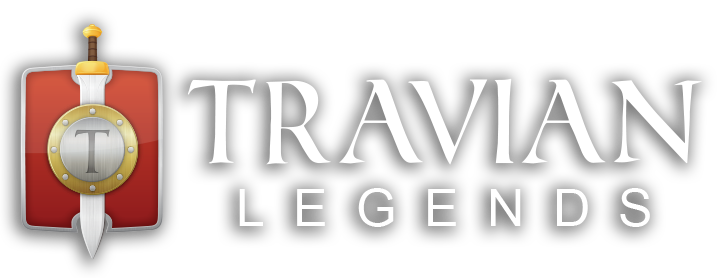
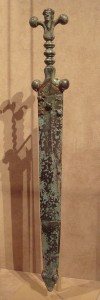
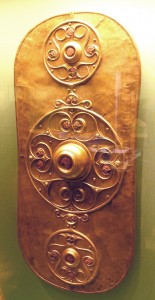
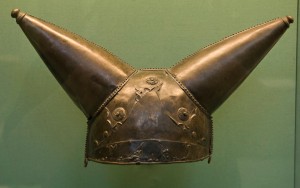
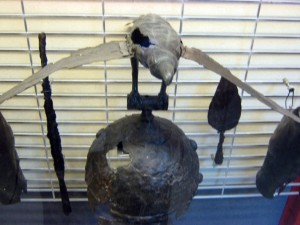
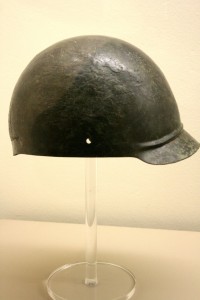
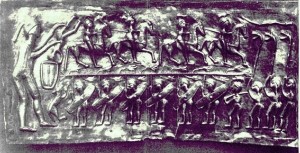
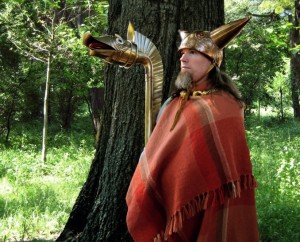
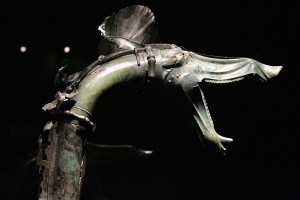

It’s really very difficult in this busy life to listen news on TV, thus I just use the web for that purpose, and get the newest information.|
Can you give more specific dimensions for the sword, carnyx, shield, and/or helmet.Thanks